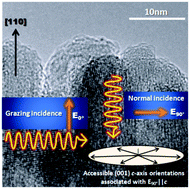On the orbital anisotropy in hematitenanorod-based photoanodes
Abstract
The orbital anisotropy of

* Corresponding authors
a Department of Mechanical Engineering, University of California, Berkeley, CA 94720, USA
b
Environmental Energy Technologies Division, Lawrence Berkeley National Laboratory, Berkeley, CA 94720, USA
E-mail:
ssmao@lbl.gov
c Department of Physics, University of Wisconsin, Madison, WI 53706, USA
d Advanced Light Source, Lawrence Berkeley National Laboratory, Berkeley, CA 94720, USA
e
International Research Center for Renewable Energy, State Key Laboratory of Multiphase Flow in Power Engineering, Xi'an Jiaotong University, Xi'an 710049, China
E-mail:
lionelv@xjtu.edu.cn
f Department of Chemistry and Biochemistry, University of California, Santa Cruz, CA 95064, USA
The orbital anisotropy of

 Please wait while we load your content...
Something went wrong. Try again?
Please wait while we load your content...
Something went wrong. Try again?
C. X. Kronawitter, I. Zegkinoglou, S. Shen, J. Guo, F. J. Himpsel, S. S. Mao and L. Vayssieres, Phys. Chem. Chem. Phys., 2013, 15, 13483 DOI: 10.1039/C3CP52527A
To request permission to reproduce material from this article, please go to the Copyright Clearance Center request page.
If you are an author contributing to an RSC publication, you do not need to request permission provided correct acknowledgement is given.
If you are the author of this article, you do not need to request permission to reproduce figures and diagrams provided correct acknowledgement is given. If you want to reproduce the whole article in a third-party publication (excluding your thesis/dissertation for which permission is not required) please go to the Copyright Clearance Center request page.
Read more about how to correctly acknowledge RSC content.
 Fetching data from CrossRef.
Fetching data from CrossRef.
This may take some time to load.
Loading related content
